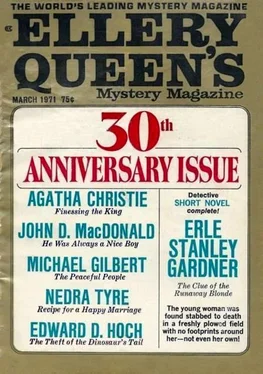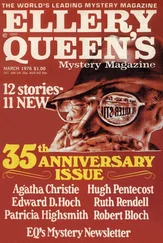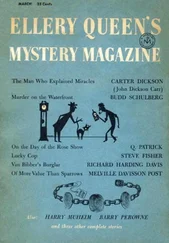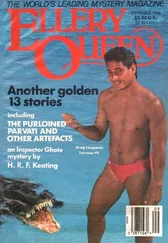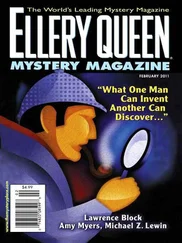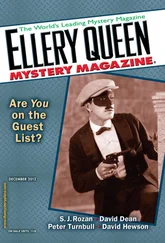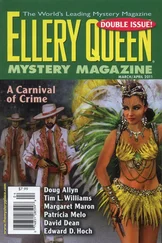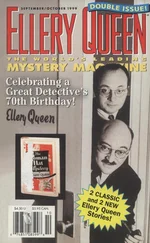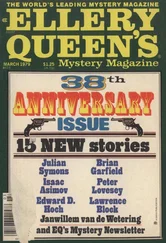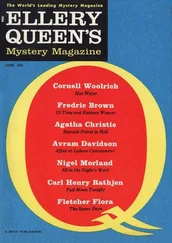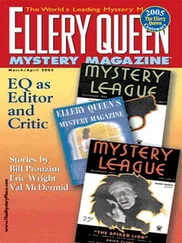Jon Breen - Ellery Queen’s Mystery Magazine, Vol. 57, No. 3. Whole No. 328, March 1971
Здесь есть возможность читать онлайн «Jon Breen - Ellery Queen’s Mystery Magazine, Vol. 57, No. 3. Whole No. 328, March 1971» весь текст электронной книги совершенно бесплатно (целиком полную версию без сокращений). В некоторых случаях можно слушать аудио, скачать через торрент в формате fb2 и присутствует краткое содержание. Город: New York, Год выпуска: 1971, Издательство: Davis Publications, Жанр: Классический детектив, на английском языке. Описание произведения, (предисловие) а так же отзывы посетителей доступны на портале библиотеки ЛибКат.
- Название:Ellery Queen’s Mystery Magazine, Vol. 57, No. 3. Whole No. 328, March 1971
- Автор:
- Издательство:Davis Publications
- Жанр:
- Год:1971
- Город:New York
- ISBN:нет данных
- Рейтинг книги:3 / 5. Голосов: 1
-
Избранное:Добавить в избранное
- Отзывы:
-
Ваша оценка:
- 60
- 1
- 2
- 3
- 4
- 5
Ellery Queen’s Mystery Magazine, Vol. 57, No. 3. Whole No. 328, March 1971: краткое содержание, описание и аннотация
Предлагаем к чтению аннотацию, описание, краткое содержание или предисловие (зависит от того, что написал сам автор книги «Ellery Queen’s Mystery Magazine, Vol. 57, No. 3. Whole No. 328, March 1971»). Если вы не нашли необходимую информацию о книге — напишите в комментариях, мы постараемся отыскать её.
Ellery Queen’s Mystery Magazine, Vol. 57, No. 3. Whole No. 328, March 1971 — читать онлайн бесплатно полную книгу (весь текст) целиком
Ниже представлен текст книги, разбитый по страницам. Система сохранения места последней прочитанной страницы, позволяет с удобством читать онлайн бесплатно книгу «Ellery Queen’s Mystery Magazine, Vol. 57, No. 3. Whole No. 328, March 1971», без необходимости каждый раз заново искать на чём Вы остановились. Поставьте закладку, и сможете в любой момент перейти на страницу, на которой закончили чтение.
Интервал:
Закладка:
Ellery Queen’s Mystery Magazine, Vol. 57, No. 3. Whole No. 328, March 1971

The Gobineau Necklace
by James Powell [1] © 1971 by James Powell.
Another of James Powell’s absolutely charming stories of San Sebastiano ... and sharpen your wits: clever, crafty, cunning, this Louis Tabarin, diamond merchant extraordinaire; when Tabarin wanted a diamond necklace for his antique-jewelry collection — even if it was the last of a family’s heirlooms and with a potent legend to protect it — he left no stone (no pun intended) unturned...
In the Riviera Principality of San Sebastiano the name Tabarin et Cie means diamonds of the first water and pearls of great price. Louis Tabarin’s jewelry shop on the rue Mazeppa had brought him not only wealth but entry into the best society where he was admired for his impeccable sense of style and envied for his air of bored imperturbability. And yet here he was, stopped dead in his tracks and his mouth ajar, on the Opera’s broad marble and onyx staircase as the intermission crowd pushed by him on both sides. Below, just inside the refreshment salon, was the most exquisite diamond necklace the renowned jeweler had ever seen.
Tabarin moved closer. The salon was crowded and he was able to stand almost next to the diamonds and the weak-chinned little woman who wore them. The stones were all six-sided, an old-fashioned cut which the ancients believed brought good luck. The setting was superb: Sixteenth Century, definitely from Rotterdam and probably by van Gelder.
As Tabarin watched, the woman was presented with a glass of punch by a short man with sad bulging eyes and a thin black mustache. Together they were a study in gentility gone to seed: his cigarette holder was gold-inlaid ivory, but his brand, Grand Moguls, was the cheapest; her dress — a dusty mauve with mutton-chop sleeves — belonged to quite another age. And yet the necklace was worth at least three-quarters of a million francs — even more to Tabarin who was a passionate collector of antique jewelry.
Tabarin admired the necklace until the sound of a buzzer announced the final act. Reluctantly he returned to his box, resolved to have the necklace for his collection. Of course, as he knew from past experience, acquiring it might prove to be a delicate matter. More often than not, the direct approach, the blunt offer to buy, proved disastrous. Once Tabarin had coveted a Twelfth Century episcopal ring, the last valuable possession of a certain Lady Milgrain who lived in a damp bed-sitting room in a squalid house run by an immense ox of a woman with bad teeth. Several visits to Lady Milgrain had failed. “As the last of my line I intend to take the ring with me to the grave,” she told him over weak tea and broken cookies. “Perhaps a tradesman would find that hard to understand,” she had added with a little smile.
But that particular story had a satisfactory ending. A few months later Lady Milgrain passed away in her sleep. It was the landlady who found her body. So when the ring was not among the dead woman’s effects, Tabarin knew where to go. With a wink and a poke in the ribs the landlady had sold him the ring for a fraction of its value.
Outside the Opera, Tabarin located the couple again just as they were getting into a cab, she wearing a woolen shawl over her shoulders, he a plastic raincoat. Tabarin followed them across the Pont des Coeurs and into the once fashionable Faubourg St. Médor. Their destination was the Hotel Sébastopol, a narrow, decaying structure wedged in between a shuttered drug store and a pastry shop.
As Tabarin entered the lobby the couple’s feet were just disappearing up the wrought-iron cage of the elevator shaft. The concierge came out of a room behind the hotel desk. “May I help the gentleman?” he asked.
“I thought I recognized the man and woman who just arrived,” said Tabarin.
“You mean the Count and Countess de Gobineau,” said the concierge, throwing his shoulders back proudly as if to say, “Imagine them staying in a hotel like this,” and then shrugging as if to add, “It is a pity they’ve fallen so low.”
Tabarin started to go. But then he turned back and dropped a business card on the desk. “The Countess placed a necklace in the hotel safe, did she not?” he asked.
“I was sure I knew you from somewhere, Mr. Tabarin,” said the concierge, pulling a racing form from under the counter. “The Beaulieu racetrack. I too am a follower of the sport of kings. I—”
“I would like to examine that necklace,” said Tabarin, laying a banknote on the counter.
The concierge drew back. “Ah, no,” he said firmly. “Maybe we aren’t the Hotel Prince Adalbert, but still, our guests have rights!”
“I admire your discretion,” said Tabarin. “It should be rewarded.” He tapped the banknote. “This plus a sure thing at Beaulieu tomorrow.” The concierge bit his lip and looked nervously to the left and right. Then he motioned Tabarin behind the counter and into the back room. He watched from the doorway while Tabarin examined the necklace diamond by diamond with a pocket glass. The diamonds were magnificent — each stone without flaw, and all drawn together in a setting at once bold and delicate.
“Trottoir in the third,” said Tabarin, returning the necklace to its green leather box and the box to the concierge. “And you needn’t mention this to the Count and Countess.”
Among the inhabitants of the fringe of San Sebastiano high society was Madame Olga Knapp, a cynical, aggressive widow who supported herself on commissions earned for bringing customers to the more expensive shops. Tabarin’s question surprised her. Yes, as a matter of fact, she had met the Count and Countess de Gobineau at a lavish dinner party thrown by the Bile King — her contemptuous nickname for an American patent-medicine tycoon with a childlike reverence for titled nobility. But Madame Knapp dismissed the couple with a wave of her hand.
“The Countess didn’t say ‘boo’ all evening,” she said. “And the Count added nothing to the occasion but a hearty appetite. A pathetic couple. I find pathetic people a bore, don’t you?”
Tabarin left the question unanswered. “I’m having a few friends over for drinks this evening. Perhaps you would care to join us, Madame Knapp,” he said.
An invitation to Tabarin’s house was a rare and coveted honor. Madame Knapp was quick to accept. “Excellent,” said Tabarin coldly. “And perhaps your friends the Count and Countess de Gobineau would care to join us as well.” This, his tone made clear, was the price of her invitation.
The evening began tediously. Nothing Tabarin said could put the timid little Countess at her ease in the presence of the rich, the famous, and the witty. As for the Count, what few opinions Tabarin could get him to utter were painfully mundane.
Finally Tabarin decided to make his move. General Klostermann, retired Chief of Staff of the army of San Sebastiano had just launched off on his favorite topic: the nature of war following the nuclear holocaust when, Klostermann believed, the sabre charge would come into its own again. He liked to illustrate this point down on his hands and knees using lead uhlans and spahis which he carried with him everywhere in a large cardboard box.
Tabarin chose this moment to show de Gobineau his study, including his shelf of rare first editions (“I’m not much of a reader,” said the Count), his collection of erotic engravings (“What’ll they think of next,” said the Count), and his admirable still-life of oranges, apples, and cheese by Marbeuf (“Cheese gives me heartburn,” said the Count).
Читать дальшеИнтервал:
Закладка:
Похожие книги на «Ellery Queen’s Mystery Magazine, Vol. 57, No. 3. Whole No. 328, March 1971»
Представляем Вашему вниманию похожие книги на «Ellery Queen’s Mystery Magazine, Vol. 57, No. 3. Whole No. 328, March 1971» списком для выбора. Мы отобрали схожую по названию и смыслу литературу в надежде предоставить читателям больше вариантов отыскать новые, интересные, ещё непрочитанные произведения.
Обсуждение, отзывы о книге «Ellery Queen’s Mystery Magazine, Vol. 57, No. 3. Whole No. 328, March 1971» и просто собственные мнения читателей. Оставьте ваши комментарии, напишите, что Вы думаете о произведении, его смысле или главных героях. Укажите что конкретно понравилось, а что нет, и почему Вы так считаете.
